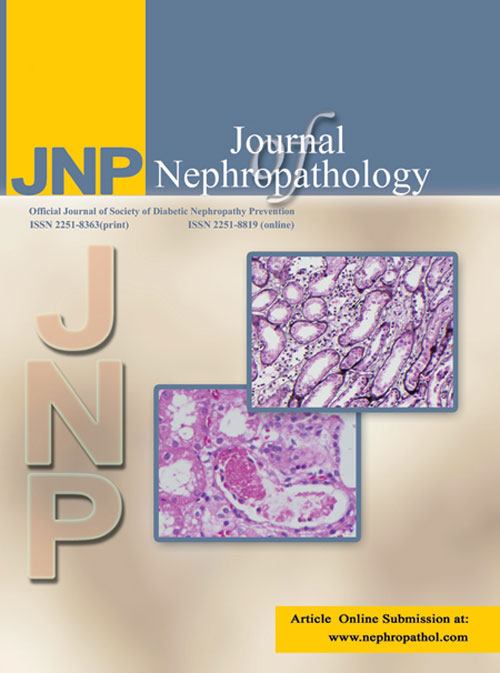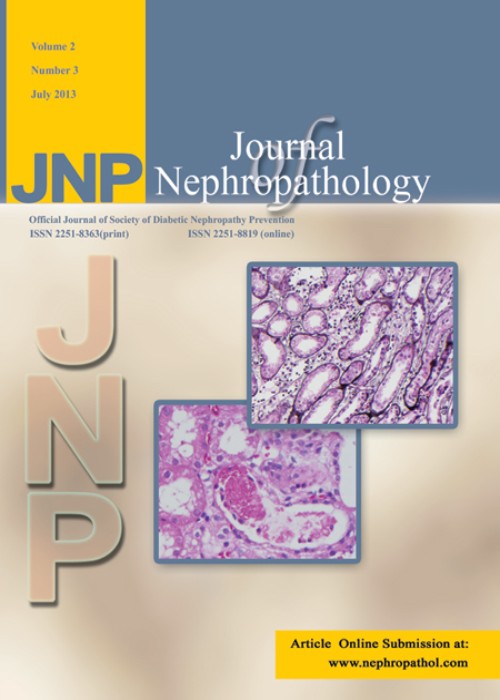فهرست مطالب

Journal of nephropathology
Volume:9 Issue: 1, Jan 2020
- تاریخ انتشار: 1398/11/05
- تعداد عناوین: 11
-
Page 4
There are few publications reporting adverse effects of metformin for patients with type 2 diabetes mellitus (T2DM) and chronic kidney disease (CKD). Although some of these reports have made big claims about the adverse effects of metformin in patients with renal failure, the majority of studies showed a superior safety profile for metformin compared with other antidiabetic medications in these patients. Further, metformin use is not contributing to an increased incidence of acute kidney injury (AKI). In conclusion, we suggest that a low dose of metformin is safe to use in patients with or without CKD. Multicenter randomized trials are required to further discover the benefits of the risk of metformin therapy in different stages of CKD and its effect on progression of CKD.
Keywords: Metformin_Type 2 diabetes_Acutekidney injury_Chronic kidney disease_Renal failure_Lactic acidosis_End-stage renal disease_Glomerularfiltration rate -
Page 5
Iodinated contrast agents are routinely used to diagnose a variety of diseases especially malignant tumors. They are crucial for accurate depiction of tumors, monitoring the response to treatment, and assessing possible recurrence of malignant lesions. Unfortunately, there are potential adverse effects associated with their administration. Metformin as an antidiabetic drug is prescribed widely. The drug is usually administered to control type II diabetes mellitus. One of the most important side effects of metformin is the possibility of lactate accumulation and occurrence of metforminassociated lactic acidosis (MALA), which develops under various circumstances including decreased renal function or concurrent use of toxic agents. Since, intravascular injection of iodinated contrast agents for radiologic purposes may result in kidney injury, it is suggested that metformin should be held in diabetic patients with renal failure before administration of contrast media and not to be taken by the patient again till 48 hours after the procedure and assessment of kidney function which should be normal.
Keywords: Metformin, Renal injury, Contrast medium, Diabetes mellitu -
Page 6Introduction
Medicinal plants are used in diabetes treatment. Salvia mirzayanii Rech. F& Esfand was used for diabetes treatment in Iranian traditional medicine.
ObjectivesThe main objective of this study is to investigate the antidiabetic effects of aqueous extract of S. mirzayanii in diabetic patients. Patients and
MethodsIn the present randomized controlled trial study, the patients were divided into trial (n=27) and control (n=25) groups. The trial group received daily one capsule containing 450 mg of aqueous extract of Salvia mirzayanii; the control group received daily one capsule containing 450 mg of caramelized flour and 5% aqueous extract of S. mirzayanii. Fasting blood samples were collected at the beginning of the study and after 3 months, fasting blood sugar (FBS), HbA1 C, insulin, HOMAIR index, alanine transaminase (ALT), aspartate transaminase (AST), and lipid profile were evaluated.
ResultsTypes of used drugs, gender, age, and body mass index (BMI) were not significantly different between trial and control groups before treatment. Additionally, after treatment, BMI did not significantly change between these two mentioned groups. The results showed that FBS and HbA1 C levels did not change significantly in the trial group after treatment; however, in this group, insulin secretion was increased significantly (P=0.015). Nevertheless; after treatment, HOMA-IR index did not significantly change between the two mentioned groups. In the trial group, after treatment, liver enzymes (ALT and AST) levels did not change significantly. After the treatment, LDL-C was changed in the trial group.
ConclusionThe herbal drug used in the present study enhanced insulin secretion, and improved LDL-C level in diabetic patients.
Keywords: Salvia mirzayanii extract_Type 2 diabetes mellitus_Fasting blood sugar_Glycosylated hemoglobin -
Page 7Introduction
Mortality rates are high in end-stage renal disease due to cardiovascular complications. Perfusion of the myocardium declines during and after hemodialysis sessions with the potential for aerobic exercise to mitigate these during hemodialysis.
ObjectivesThe purpose of this study was to investigate acute changes in hemodynamics in subjects with end-stage renal disease (ESRD) during exercise. Patients and
MethodsSubjects (n = 10) were monitored for 1.5 hours during hemodialysis treatment during a control (CON) and an exercise (EX) session. Subjects cycled using an ergometer strapped to the reclining dialysis chair at an RPE of 11-13 for 30 minutes during the EX session beginning at 30 min into dialysis and ending at 60 minutes. Data for systolic blood pressure (SBP), diastolic blood pressure (DBP), and mean arterial pressure (MAP) were collected using an automated blood pressure cuff attached to the hemodialysis machine. Data for cardiac output (Q̇ ), cardiac power index (CPI), stroke volume (SV), systemic vascular resistance (SVR), and heart rate (HR) were collected using the NICaS bioelectrical impedance device.
ResultsDuring the EX session, CPI, Q̇ , SV, and HR were significantly greater (P<0.05) than the CON session. Additionally, Q̇ was significantly (P< 0.05) greater at 45 minutes and 60 minutes compared to 15 minutes. HR was significantly (P<0.05) greater at 45 minutes compared to 90 minutes. No significant interactions were found for MAP, CPI, Q̇ , HR, SV, SBP, DBP, or SVR.
ConclusionIn conclusion, exercise during dialysis may decrease the likelihood of experiencing ischemic or hypotensive events by enhancing myocardial perfusion through increasing CPI and Q̇ .
Keywords: Cardiovascular, Dialysis, Exercise, Kidney, End-stage renal disease, Chronic kidney disease -
Page 8Introduction
Thymoglobulin is a lymphocyte-depleting polyclonal antibody, administered for induction therapy at the time of kidney transplantation to reduce the risk of acute allograft rejection. The appropriate dosage and duration of therapy is controversial. The higher dosages are associated with infection and malignancy.
ObjectivesIn this study efficacy and safety of lower dosage (in comparison with previous studies) of thymoglobulin in kidney transplant recipients was evaluated. Patients and
MethodsIn this clinical trial, 106 adult kidney transplant recipients, were randomized before transplantation in two groups (case and control). The case group (53 patients) were received induction therapy with thymoglobulin (1.5 mg/kg/d for 3 days) and the control group (53 patients) were received non-induction regiment. Delayed graft function (DGF), glomerular filtration rate (GFR), acute allograft rejection and thymoglobulin complications were evaluated during the first post-transplantation year.
ResultsAround 106 kidney transplant recipients were enrolled (71 or 66.98% deceased donor) to the study. No significant statistical differences were found in GFR at the time of discharge from hospital (P=0.399) and at 1 year (P=0.851) and acute allograft rejection (P= 0.304) between two groups. Graft survival (73.5% in case group versus 81.1% in control group, P=0.392) at month 12th was similar among groups. Additionally, no significant differences of acute allograft rejection in recipient from deceased or living donor between two groups were detected. There was a higher incidence of DGF in the control group (26.4%) than the thymoglobulin group (5.8%) and the difference was statistically significant (P= 0.004). Thrombocytopenia (17% versus 49.1%, P<0.001) and leukopenia (11.3% versus 50.9%, P<0.001) were also significantly higher in the case group.
ConclusionWhile the incidence of DGF was reduced in thymoglobulin group, the short-term acute allograft rejection rate was not reduced compared to the control group. However, our results require further consideration with larger samples.
Keywords: Kidney transplantation, Induction therapy, Thymoglobulin, Acute allograft rejection, End-stage renal disease, Hemodialysis, Immunosuppression, Anti-thymocyte globulin -
Page 9Introduction
Studies have shown when hemodialysis treatment is sufficiently effective, complications of uremic syndrome, additional treatment costs and hospitalization length are reduced. Several methods have been proposed to improve hemodialysis adequacy.
ObjectivesIn this study, the effects of the synchronic use of the stepwise profile dialysis fluid flow rate with increased blood flow rate (BFR) were studied on hemodialysis adequacy. Patients and
MethodsThis is a cross-over clinical trial study conducted on 34 hemodialysis patients selected from a hemodialysis center of Qazvin University of Medical Sciences, Qazvin, Iran. The patients were randomly allocated into two groups (n= 17 patients in each group) in two sequences. In the first sequence, the subjects received four routine hemodialysis sessions in group one and four hemodialysis sessions with the stepwise profile of the fluid flow rate with increased BFR in group two. In the second sequence, the treatment methods were exchanged. Hemodialysis sessions were performed in both sequences, consecutively. Each session was at least three hours. Hemodialysis adequacy was measured using Kt/V software on the hemodialysis machines after each session.
ResultsThe mean score of dialysis adequacy was 0.89 in the routine method and 1.26 in the profile with increased BFR. There was a statistically significant difference between the methods (t= -7.9, df = 33, P < 0.001).
ConclusionThe results of the study suggest that the stepwise profile of the dialysis fluid flow rate with increased BFR should be used synchronously to improve hemodialysis adequacy.
Keywords: Hemodialysis, Dialysis adequacy, Chronic kidney disease, End-stage renal disease -
Page 10
Infective endocarditis is a diagnostic challenge since it could manifest as a systemic disease mimicking rheumatologic disorders by immunological mechanisms. We introduced a case of infective endocarditis which was a 62-year-old man who presented with weakness, weight loss, myalgia, arthritis, petechiae, hematuria and proteinuria and was admitted by a rheumatologist for evaluation of possible vasculitis.
Keywords: Infective endocarditis, Vasculitis, Post-infectious glomerulonephritis -
Page 11
In kidney transplant recipients, the renal artery stenosis is cause of graft dysfunction and graft loss. Here we describe a case that leads to graft loss. The nephrologist should know about its etiologies, symptoms and diagnostic tools and also its treatment after renal transplantation. Keywords: Transplant renal arterial stenosis, Kidney transplant, Renal artery stenosis, Graft loss, Acute renal artery thrombosis, End-stage kidney failure


